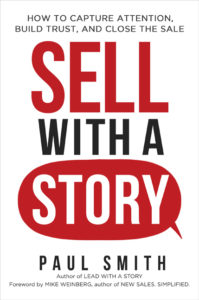Podcast: Play in new window | Download | Embed
Subscribe: RSS
Podcast (sell-with-a-story-series1): Play in new window | Download | Embed
Subscribe: RSS
 {The 19th in a series of the 25 most useful sales stories}
{The 19th in a series of the 25 most useful sales stories}
One powerful use of storytelling in sales is to resolve your buyers’ objections before they’re even brought up. I’ve come across two different methods to do this, so I’ll cover one in this post and the other in the next.
The first technique is probably best summarized with the phrase, “That’s what I thought at first, too. But then. . .” Here’s an example of that technique in action from the director of market research at Aflac, Randy Locke.
As a researcher, Randy’s job isn’t to sell products. He traffics in ideas. And it’s his job and the job of his team to recommend strategic courses of action to senior management, often when that recommendation conflicts with the personal opinion of one of those senior managers. (That’s kind of like when a buyer has an objections to something you’ve said in your sales pitch.)
And it’s those situations, when he’s trying to advance an unpopular idea, that Randy’s learned the most about selling and about storytelling.
The most straightforward way to bring up his disagreements with management, of course, is to simply state those disagreements and explain them. For example, he might say,
I’ve looked at the most recent strategy document and I disagree with points #2 and #4, and here are my reasons why . . .”
But human beings, being what they are, tend to not like being told that they’re wrong about something, especially in front of their peers. We can get defensive and inadvertently put up more of a barrier to the new ideas than is warranted, throwing out objection after objection in more of an attempt to rescue our pride than make the best decision.
Randy’s found it to be more effective to tell a story about how his team started out in complete support of a new plan, but then how they came to find their point of disagreement. That might sound something like this:
We were really excited to get the new strategy document and started digging through our research to help flesh out the ideas. But as we were doing that, we came across some research that made us question points #2 and #4. We were surprised to find out that . . .”
And from there, Randy launches into his journey of research that led to the epiphany in the first place.
Of course, all of the same points that would be brought up in the more direct approach would be mentioned in the storytelling approach. The difference is that the straightforward approach is set up from the beginning as an adversarial conversation: “I’m right and you’re wrong, and here’s why.”
But the second approach, using storytelling, is set up as a journey of discovery. It starts in the same intellectual place as the audience. So, instead of feeling confrontational or adversarial, the audience feels more of a sense of being on a joint adventure and is eager to see where the journey leads. “That’s what I thought at first, too. But then. . .” As a result, Randy is more likely to end up with an agreement than a headache.
So, if you’ve got ideas to share with your prospects or buyers that are likely to be seen as contrary to their opinion on something, develop your own “That’s what I thought at first, too. But then. . .” story to explain how you came to your controversial position. You’ll have a much better chance at success.
Use these links to subscribe to this podcast on iTunes or Stitcher, or Podbean.
Source: Sell with a Story: How to Capture Attention, Build Trust, and Close the Sale, by Paul Smith.
—
 Paul Smith is one of the world’s leading experts on business storytelling. He’s a keynote speaker, storytelling coach, and bestselling author of the books Lead with a Story, Parenting with a Story, and Sell with a Story.
Paul Smith is one of the world’s leading experts on business storytelling. He’s a keynote speaker, storytelling coach, and bestselling author of the books Lead with a Story, Parenting with a Story, and Sell with a Story.


 Connect with him via email here.
Connect with him via email here.
Follow him on Facebook, LinkedIn, Twitter, and Instagram.
Sign up for his newsletter here to get one new story a week delivered to your inbox.

